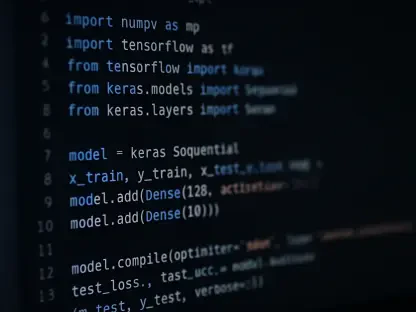In recent years, advancements in real-time graphics have been pivotal for the gaming industry, which continuously demands improved visual quality and performance. With the introduction of Microsoft’s latest DirectX Agility SDK, significant strides have been made in the realm of ray tracing. This SDK brings to the forefront impressive technologies such as Shader Execution Reordering (SER) and Opacity Micromaps (OMM). These innovations aim to optimize graphics performance by utilizing next-generation GPU capabilities efficiently. Consequently, their adoption could drastically enhance gaming experiences by delivering higher frame rates and unprecedented visual realism without sacrificing quality.
Shader Execution Reordering: A New Approach to Thread Optimization
Optimizing GPU Thread Execution
Shader Execution Reordering (SER) stands out as a revolutionary feature in the new DirectX Agility SDK. At its core, SER allows applications to provide valuable insights to GPU drivers about efficiently ordering thread execution, an action paramount in reducing divergence and improving coherence in execution paths. By doing this, SER ensures that GPUs can maintain higher levels of parallelism, which is crucial for realizing substantial performance enhancements. In practical terms, it has demonstrated an ability to potentially double the performance of games based on path-tracing algorithms, allowing gamers to experience smoother and more responsive gameplay.
The benefits of SER extend beyond just enhancing real-time gaming graphics. By improving thread management, this technology can also reduce processing times for other GPU-intensive applications, such as complex simulations or high-resolution video editing. This enhanced efficiency in execution paths means that developers can exploit the hardware’s full potential while maintaining exquisite levels of visual detail. The potential for SER to impact disciplines beyond gaming is vast, positioning it as a vital tool in the future of computational graphics.
Enhancing Path-Traced Game Performance
The use of SER specifically within the context of path-traced gaming environments marks a transformative leap. Previously, one of the most significant challenges was managing the varied execution times of individual threads on a GPU, often resulting in suboptimal performance. By introducing a method to reorder these tasks dynamically, SER ensures that the workload is evenly distributed, enhancing overall system performance and enabling more fluid transitions in visually intense scenarios.
Additionally, game developers can now explore more complex visual effects and detailed environments without being overly concerned about performance drops. This capability is crucial as players increasingly demand realism and intricacy in game worlds. With SER, developers can push creative boundaries while maintaining high FPS, essential for an immersive experience. This balance between complexity and performance opens up possibilities for new types of interactive storytelling and visually rich gaming experiences, expanding the creative landscape for digital content creators.
Opacity Micromaps: A Leap in Real-Time Transparency Handling
Addressing Alpha-Transparencies in Ray Tracing
Opacity Micromaps (OMM) represent another groundbreaking addition in the DirectX Agility SDK, specifically tailored for handling alpha-transparent textures more efficiently. In traditional graphics rendering, handling transparency has always posed challenges due to the computationally heavy AnyHit shader operations required for each pixel. OMM circumvents these issues by enabling hardware-accelerated alpha testing, effectively reducing the need to invoke the AnyHit shader process as frequently, thus optimizing performance without sacrificing visual integrity.
This new method allows for better management of transparent textures, which are often complex and require significant computational resources to process accurately. By minimizing the processing load associated with these elements, OMM can lead to drastic improvements in rendering times. For example, NVIDIA’s demonstrations have shown substantial improvements in FPS within intricate scenes, underscoring the value of this technology in enhancing both performance and visual quality in challenging rendering scenarios.
Advancing Performance in Path-Traced Scenarios
In path-traced scenarios, where realism is achieved through simulating complex interactions of light across surfaces, the role of OMM is pivotal. The ability to handle intricate transparency with such precision allows for more realistic visual outputs, making light interactions appear more natural. This advancement notably alleviates many challenges previously associated with alpha-tested geometry, such as performance bottlenecks and rendering artifacts. It has been noted that OMM can boost performance by up to 2.3 times in such scenarios, setting a new benchmark for efficiency.
Moreover, by optimizing how transparencies are handled, these micromaps set the stage for new graphical possibilities, enabling developers to design scenes with intricate details and realistic depictions of transparent materials like glass and water. These improvements are crucial as developers work towards delivering more lifelike gaming experiences where every visual element, from reflections to refractions, is simulated with higher fidelity. Therefore, OMM not only contributes to better performance but also enriches the visual storytelling capabilities of modern video games.
Additional Features Driving Innovation
Enhancing Graphics with Cooperative Vectors and Video Encoding
Beyond the headline features of SER and OMM, the DirectX Agility SDK introduces other notable enhancements aimed at pushing the envelope of what modern GPUs can achieve. Cooperative Vectors, aimed at improving hardware acceleration for vector and matrix operations, provide a significant boost for integrating neural rendering techniques. This advancement aligns with the increasing trend toward machine learning and AI applications in gaming and content creation, where these operations are often central to delivering high-quality output efficiently.
Complementing this, the SDK also includes updates to Direct3D video encoding, incorporating features like HEVC Reference List extension and dual-pass encoding. These additions expand the capabilities of video processing pipelines, offering improved quality and efficiency. The introduction of new signal-to-noise features further refines video encoding processes, providing cleaner and crisper video outputs crucial for both real-time applications and broadcast-quality productions. These enhancements serve dual purposes, catering to both performance-oriented applications and high-quality visual outputs.
D3D12 Tiled Resource Tier 4 and Broader Industry Support
The release of the D3D12 Tiled Resource Tier 4 marks another pivotal update, lifting previous restrictions on mip-packed arrays, thus providing a more flexible and efficient approach to texture streaming. This feature is intended to enhance the streaming process for large and detailed game worlds, allowing for smoother transitions between textures without sacrificing load times or image quality. The broader implication of this update is a more adaptive and fluid visual experience, where large-scale environments can be rendered more efficiently.
Support from major industry players such as AMD and Intel, along with NVIDIA’s full compatibility with these latest advancements, underscores the significant industry-wide shift towards embracing these innovations. Their commitment to integrating these updates in forthcoming driver releases ensures a smooth transition for developers looking to harness these new capabilities. This synchronized industry movement promises to facilitate widespread adoption and underscores the relevance and potential impact of these features across various applications in the technology landscape.
Impact and Future Outlook
In recent years, the gaming industry has heavily relied on advancements in real-time graphics to meet its ever-growing demands for improved visual quality and performance. This continuous push for higher standards has led to the introduction of Microsoft’s latest DirectX Agility SDK, a breakthrough that marks significant progress in ray tracing technology. At the heart of this SDK are cutting-edge features like Shader Execution Reordering (SER) and Opacity Micromaps (OMM), each aimed at maximizing graphics performance. These technologies leverage next-gen GPU capabilities to enhance efficiency, setting the stage for gaming experiences that are richer and more immersive than ever before. By implementing SER and OMM, developers can achieve elevated frame rates and fascinating visual realism, all without compromising on quality. As these innovations become more widely adopted, gamers can expect a notable transition in aesthetic standards, ensuring the delivery of a captivating and fluid gameplay environment that meets modern expectations.









